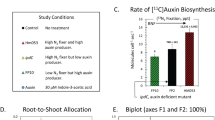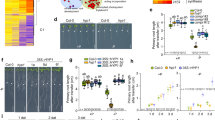Abstract
THE D-threo isomer of chloramphenicol is an antibiotic and a specific inhibitor of protein synthesis in bacteria1. It also inhibits protein synthesis (net synthesis or turnover) in higher plants2–6, including cell-free systems7,8. Suppression of the induced increase in oxygen uptake in potato disks by D-chloramphenicol9 has been considered as indirect evidence of an inhibition of protein (possibly cytochrome oxidase) synthesis. Enzyme development during germination was also inhibited by D-chloramphenicol10,11. Recently, this chemical has also been used in several systems to relate ion uptake to protein synthesis in higher plants2,3,6,12–16. Others oppose this interpretation17–20. Meanwhile, the extrapolation of information on chloramphenicol from bacteria to higher plant systems has been criticized4,18. Ellis18, for example, observed that D-chloramphenicol did not affect incorporation of amino-acids into protein (trichloroacetic acid (TCA)-insoluble fraction) and yet it reduced ion uptake in higher plants. In contrast, the L-threo-isomer of chloramphenicol, which is neither an antibiotic nor an inhibitor of protein synthesis in bacterial systems, does inhibit ion uptake18 and root growth21 in higher plants. Thus, further elucidation was necessary as to the action of chloramphenicol as an inhibitor of ion uptake via an effect on protein synthesis.
This is a preview of subscription content, access via your institution
Access options
Subscribe to this journal
Receive 51 print issues and online access
$199.00 per year
only $3.90 per issue
Buy this article
- Purchase on Springer Link
- Instant access to full article PDF
Prices may be subject to local taxes which are calculated during checkout
Similar content being viewed by others
References
Brock, T. D., Bact. Rev., 25, 32 (1961).
Jacoby, B., and Sutcliffe, J. F., Nature, 195, 1014 (1962).
Jacoby, B., and Sutcliffe, J. F., J. Exp. Bot., 13, 335 (1962).
Molotkovskii, Yu G., and Smirnow, A. M., Soviet Plant Physiol., 10, 268 (1963).
Nooden, L. D., and Thimann, K. V., Proc. U.S. Nat. Acad. Sci., 50, 194 (1963).
Peaud-Lenoël, C., and de Gouray-Margerie, C., Phytochem., 1, 267 (1962).
Rabson, R., and Novelli, G. D., Proc. U.S. Nat. Acad. Sci., 46, 484 (1960).
Webster, G. C., J. Biol. Chem., 229, 535 (1957).
Calo, N., Marks, J., and Varner, J. E., Nature, 180, 1142 (1957).
Srivastava, B. I. S., and Meredith, W. O. S., Canad. J. Botany, 40, 1257 (1962).
Young, J. L., and Varner, J. E., Arch. Biochem. Biophys., 84, 71 (1959).
Bowling, D. J. F., Nature, 200, 284 (1963).
Höffner, W., Naturwiss., 50, 720 (1963).
Jyung, W. H., and Wittwer, S. H., Amer. J. Bot., 51, 437 (1964).
Sutcliffe, J. F., Nature, 188, 294 (1960).
Uhler, R. L., and Russell, R. S., J. Exp. Bot., 14, 431 (1963).
Balough, E., Böszörményi, Z., and Cseh, E., Biochim. Biophys. Acta, 52, 381 (1961).
Ellis, R. J., Nature, 200, 596 (1963).
Hanson, J. B., and Hodges, T. K., Nature, 200, 1009 (1963).
Stoner, C. D., Hodges, T. K., and Hanson, J. B., Nature, 203, 258 (1964).
Rønnike, F., Physiol. Plant., 11, 421 (1958).
Zaitlin, M., Nature, 184, 1002 (1959).
Jyung, W. H., Wittwer, S. H., and Bukovac, M. J., Plant Physiol. (in the press).
Click, R. E., and Hackett, D. P., Proc. U.S. Nat. Acad. Sci., 50, 243 (1963).
Dilley, D. R., and Walker, D. R., Plant Physiol., 36, 757 (1961).
Pollard, J. K., and Steward, F. C., J. Exp. Bot., 10, 17 (1959).
Sutcliffe, J. F., and Bollard, E. J., Steward, F. C., J. Exp. Bot., 11, 151 (1960).
Author information
Authors and Affiliations
Rights and permissions
About this article
Cite this article
JYUNG, W., WITTWER, S. & BUKOVAC, M. Ion Uptake and Protein Synthesis in Enzymatically Isolated Plant Cells. Nature 205, 921–922 (1965). https://doi.org/10.1038/205921b0
Issue Date:
DOI: https://doi.org/10.1038/205921b0
This article is cited by
-
Foliar absorption — penetration of the cuticular membrane and nutrient uptake by isolated leaf cells
Qualitas Plantarum et Materiae Vegetabiles (1967)
-
Sorption of some ions by algae related to their trophic conditions
Biologia Plantarum (1966)
Comments
By submitting a comment you agree to abide by our Terms and Community Guidelines. If you find something abusive or that does not comply with our terms or guidelines please flag it as inappropriate.



